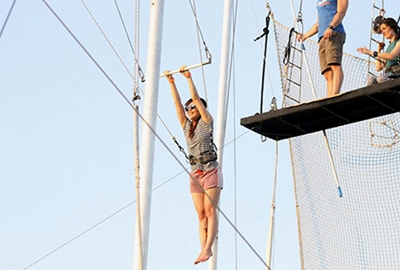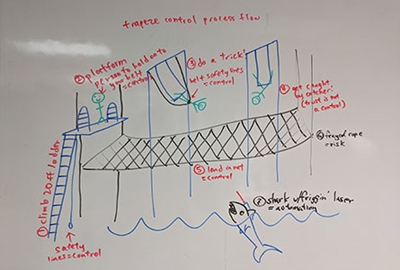Who says internal auditors are risk-averse? Raytheon Co.'s Jaimie Yang swings high in the air in her weekend pursuit — the flying trapeze. After a long week of audits, the 2016 Internal Auditor Emerging Leader says it is freeing to fly and feel the rush of adrenaline from her daring hobby.
#IAm Jaimie Yang
Blogs Jaimie Yang, CIA, CPA, CISA Oct 28, 2021

"Ready … hup!" means I am taking a 15-foot jump off a platform and flying through the air.
I am, of course, talking about my hobby of flying trapeze. In 2015, I saw a Groupon for flying trapeze lessons and convinced my friend to try it with me. The feeling of anticipation, the initial rush of adrenaline, and the peaceful, calm moments at the peaks of my swing put the biggest smile on my face. I did not consider myself an active person at the time but proved myself wrong by falling in love with not only flying trapeze but other aerial arts, as well.
Of course, I am also an internal auditor at heart. That means when I explain my hobby to my co-workers, I draw a diagram (see below) of not only the rig itself, but also the controls in place (robotic shark notwithstanding, and as a quick note on No. 6, a certified rigger inspects the rig at least monthly and replaces parts as they start to show wear).
Here is how a typical flying trapeze class goes:
- You climb up a set of ladders that takes you to the board. Before you climb, you clip into safety lines that function like a seat belt. If you were to slip and drop, the safety lines will stop further movement past the initial point.
- At the top of the board, the board worker swaps your ladder lines for the ones attached to the trapeze rig. While the board worker holds on to the back of your belt, you step up to the edge and grab the bar. "Ready" means bend your knees and "hup" means you jump (or bunny hop) off. The board worker will hold on to you until your feet leave the board. The word "hup" is used in lieu of "go" as "go" and "no" sound pretty similar.
- You're flying! The lines puller on the ground will instruct you through your trick. For your first class, you learn how to do a knee hang. Your calls are: legs up, hook your knees, hands off! You're clipped into those safety lines the whole time and the lines puller can assist you with building height/momentum or slowing down your descent as needed.
- For the last part of each class, you throw your trick to the catcher. The catcher is on the opposite bar with his or her legs wrapped in a secure position appropriately called the catcher's lock. You perform your trick and trust that the catcher will be there.
- When you are done with your trick or catch, you let go of the bar and land in the net. From when you jumped until when you land, you have spent approximately 20 to 30 seconds in the air, but I can tell you from experience that it feels like it is much longer!

After successfully catching your knee hang, you learn more tricks such as the pike whip, straddle whip, and split. You also will gradually be introduced to new techniques such as how to take off without a belt hold, how to kick in time with the swing and build height on your own, and how to control your body position to turn and bounce in the net. As you become more advanced, you can even learn how to turn around mid-air to return to the board after your catch and how to fly without lines.
Trapeze is my favorite way to wind down and start my weekend. There is something freeing about flying through the air and literally just letting go. I feel both physically and mentally stronger when I try something new or finally nail the trick that I've been working on for weeks. I'm not one to back down when it comes to a challenge, and doing something that I didn't know I was capable of doing brings such a strong sense of accomplishment.
While I am definitely addicted to the feeling of flying and relish the fact that there are endless things to learn, what keeps me coming back is the genuinely warm and supportive community. I have flown at a few rigs across the country as well as travelled to one in the middle of a Costa Rican rainforest with others from my local rig. Everyone I have met is just as excited as you are to celebrate your successes, and there is no shortage of encouragement when you are working to figure something out.
I encourage everyone to get outside of their comfort zone, and if you are ever in Dallas or if you fly somewhere locally and would like a friend to go with you, let me know!


